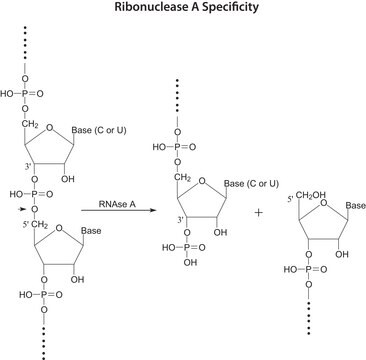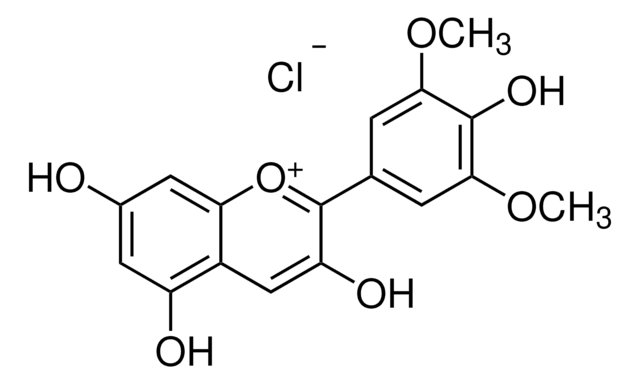HTS071M
ChemiSCREEN Membrane Preparation Recombinant Human ChemR23 Chemoattractant Receptor
Human ChemR23 / CMKLR1 GPCR membrane preparation for Radioligand binding Assays & GTPγS binding.
Autenticatiper visualizzare i prezzi riservati alla tua organizzazione & contrattuali
About This Item
Codice UNSPSC:
41106514
eCl@ss:
32161000
NACRES:
NA.84
Prodotti consigliati
Origine biologica
human
Livello qualitativo
Ricombinante
expressed in Chem-1 cells
Produttore/marchio commerciale
ChemiScreen
Chemicon®
tecniche
ligand binding assay: suitable (GTPγS)
radioligand binding assay (RLBA): suitable
N° accesso NCBI
N° accesso UniProt
Condizioni di spedizione
dry ice
Descrizione generale
ChemR23 was discovered as an orphan receptor related to the chemoattractant receptors C3a, C5a and FPR1, and expressed on dendritic cells and macrophages (Samson et al., 1998). A ligand for ChemR23 was characterized as chemerin, a 15 kD proteolytically processed protein found in inflammatory sites; a 9 amino acid peptide from the C-terminus of chemerin is sufficient to activate ChemR23 (Wittamer et al., 2003, 2004). Chemerin expressed in lymphoid and microvascular endothelium mediates migration of ChemR23-expressing dendritic cells to lymphoid organs and vasculature at sites of inflammation (Vermi et al., 2005). In addition, a bioactive lipid, resolvin E1, was found to functionally interact with ChemR23 to reduce inflammation (Arita et al., 2005). Millipore′s ChemR23 membrane preparations are crude membrane preparations made from our proprietary stable recombinant cell lines to ensure high-level of GPCR surface expression; thus, they are ideal HTS tools for screening of ChemR23 interactions with its ligands. The membrane preparations exhibit EC50s of 0.37 nM for chemerin in a GTPγS binding assay.
Full-length human ChemR23
Applicazioni
Radioligand binding assay and GTPγS binding.
Azioni biochim/fisiol
GPCR Class: A
Protein Target: ChemR23 / CMKLR1
Target Sub-Family: Chemoattractant
Qualità
SPECIFICATIONS: 1 unit = 5 μg
EC50 in GTPγS binding assay by Chemerin: ~ 0.37 nM
EC50 in GTPγS binding assay by Chemerin: ~ 0.37 nM
Specifiche
Inucbation Conditions
ASSAY CONDITIONS: Membranes are permeabilized by addition of saponin to an equal concentration by mass, then mixed with [35S]-GTPγS (final concentration of 0.3 nM) in 20 mM HEPES, pH 7.4/100 mM NaCl/10 mM MgCl2/0.5 μM GDP in a nonbinding 96-well plate. Unlabeled chemerin was added to the final concentration indicated in Figure 1 (final volume 100 μL), and incubated for 30 min at 30°C. The binding reaction is transferred to a GF/B filter plate (Millipore MAHF B1H) previously prewetted with water. The plate is washed 3 times (1 mL per well per wash) with cold 10 mM sodium phosphate, pH 7.4, then dried and counted.
One vial contains enough membranes for at least 200 assays (units), where one unit is the amount of membrane that will yield greater than 1000 cpm specific chemerin-stimulated [35S]-GTPγS binding.
The ChemR23 membrane preparation is expected to be functional in a radioligand binding assay; however, the end user will need to determine the optimal radiolabeled ligand for use with this product.
ASSAY CONDITIONS: Membranes are permeabilized by addition of saponin to an equal concentration by mass, then mixed with [35S]-GTPγS (final concentration of 0.3 nM) in 20 mM HEPES, pH 7.4/100 mM NaCl/10 mM MgCl2/0.5 μM GDP in a nonbinding 96-well plate. Unlabeled chemerin was added to the final concentration indicated in Figure 1 (final volume 100 μL), and incubated for 30 min at 30°C. The binding reaction is transferred to a GF/B filter plate (Millipore MAHF B1H) previously prewetted with water. The plate is washed 3 times (1 mL per well per wash) with cold 10 mM sodium phosphate, pH 7.4, then dried and counted.
One vial contains enough membranes for at least 200 assays (units), where one unit is the amount of membrane that will yield greater than 1000 cpm specific chemerin-stimulated [35S]-GTPγS binding.
The ChemR23 membrane preparation is expected to be functional in a radioligand binding assay; however, the end user will need to determine the optimal radiolabeled ligand for use with this product.
Stato fisico
Liquid in packaging buffer: 50 mM Tris pH 7.4, 10% glycerol and 1% BSA no preservatives.
Packaging method: Membranes protein were adjusted to 1 mg/ml in 1 ml packaging buffer, rapidly frozen, and stored at -80°C
Packaging method: Membranes protein were adjusted to 1 mg/ml in 1 ml packaging buffer, rapidly frozen, and stored at -80°C
Stoccaggio e stabilità
Maintain frozen at -70°C for up to 2 years. Do not freeze and thaw.
Note legali
CHEMICON is a registered trademark of Merck KGaA, Darmstadt, Germany
Esclusione di responsabilità
Unless otherwise stated in our catalog or other company documentation accompanying the product(s), our products are intended for research use only and are not to be used for any other purpose, which includes but is not limited to, unauthorized commercial uses, in vitro diagnostic uses, ex vivo or in vivo therapeutic uses or any type of consumption or application to humans or animals.
Codice della classe di stoccaggio
12 - Non Combustible Liquids
Classe di pericolosità dell'acqua (WGK)
WGK 2
Punto d’infiammabilità (°F)
Not applicable
Punto d’infiammabilità (°C)
Not applicable
Certificati d'analisi (COA)
Cerca il Certificati d'analisi (COA) digitando il numero di lotto/batch corrispondente. I numeri di lotto o di batch sono stampati sull'etichetta dei prodotti dopo la parola ‘Lotto’ o ‘Batch’.
Possiedi già questo prodotto?
I documenti relativi ai prodotti acquistati recentemente sono disponibili nell’Archivio dei documenti.
Il team dei nostri ricercatori vanta grande esperienza in tutte le aree della ricerca quali Life Science, scienza dei materiali, sintesi chimica, cromatografia, discipline analitiche, ecc..
Contatta l'Assistenza Tecnica.






